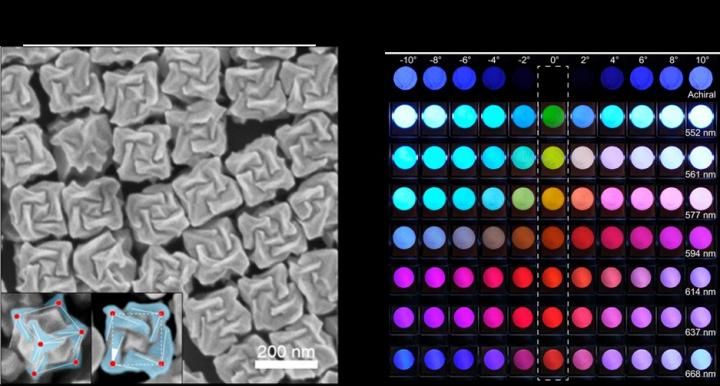Peptide induces chirality evolution in a single gold nanoparticle
For the first time, scientists have successfully created optically active, chiral gold nanoparticles using amino acids and peptides. Many chemicals significant to life have mirror-image twins (left-handed and right-handed structures), a characteristic that is conventionally called chirality. This study describes how chirality, which is typically observed in organic molecules, can be extended to three-dimensional metallic nanostructures.

This is schematic geometry of chiral gold nanoparticle, mirror imaged twins, synthesized with the chiral peptide additives.
Ki Tae Nam Research Group, Seoul National University

This is an electron microscope image of synthesized chiral gold nanoparticles (LEFT), where chiral components are highlighted in blue. Potential application in a color display as a three dimensional polarizer. (Right)
Ki Tae Nam Research Group, Seoul National University


The Korean research teams at Seoul National University (SNU), Pohang University of Science and Technology (POSTECH) and LG Display (LGD) demonstrated the direct transfer of peptide handedness to nanoparticles' morphology during their growth. Mirror-image peptide twins induced the opposite twist of the chiral nanoparticles, which are further tunable with sequence variation. The chiral gold nanoparticles with different handedness interacted differently with circularly polarized visible light, displaying extensive color modulation. As a result, color change is possible by controlling the light polarization, which has potential applications in future displays.
In newly synthesized gold nanoparticles, chiral elements are arranged on cube-like structures with a side length of only about 100 nm. They can be easily dispersed in solutions and deposited on the substrates while maintaining high chiro-optical activities.
"Based on our understanding of the interface between peptides and inorganic materials, we have built a new platform technology to control the crystallographic asymmetry," explains Professor Ki Tae Nam at SNU, who led this collaborative project. He added, "This finding can make a direct and immediate impact on optical devices and could be further applied for the development of enantioselective bioinspired catalysts in the near future."
"The potential applications include active color displays, holography, chirality sensors and all-angle negative refractive index materials," explained Professor Junsuk Rho at POSTECH, the co-corresponding author.
Original publication
Most read news
Other news from the department science

Get the life science industry in your inbox
By submitting this form you agree that LUMITOS AG will send you the newsletter(s) selected above by email. Your data will not be passed on to third parties. Your data will be stored and processed in accordance with our data protection regulations. LUMITOS may contact you by email for the purpose of advertising or market and opinion surveys. You can revoke your consent at any time without giving reasons to LUMITOS AG, Ernst-Augustin-Str. 2, 12489 Berlin, Germany or by e-mail at revoke@lumitos.com with effect for the future. In addition, each email contains a link to unsubscribe from the corresponding newsletter.
Most read news
More news from our other portals
Last viewed contents
Absence_seizure
Oncology

New discoveries about the origin of the brain’s immune system - Significance for Alzheimer’s, multiple sclerosis and more

FLUOVIEW FV4000 | Laser scanning microscopes | EVIDENT
Fast Pandemic Detection Tool Ready to Fight Flu - Agilent Technologies and Los Alamos Develop First High-Throughput System to Be Deployed at UCLA’s New Global Bio Lab
TASB_(psychedelics)

Nature Unveiling Herself Before Science - Cutting-edge technology allows for real-time monitoring of biomineralisation
Tapas_Acupressure_Technique
Arytenoid_cartilage
Bacillus_Calmette-Guérin






















































